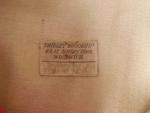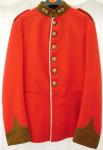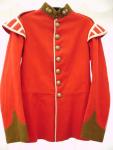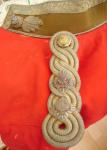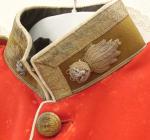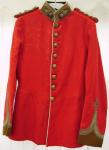-
Posts
1,065 -
Joined
-
Last visited
-
Days Won
1
Content Type
Profiles
Forums
Blogs
Gallery
Events
Store
Everything posted by Graham Stewart
-
It's very good up to a point but doesn't distiguish beween 1st & 2nd Bn's and Reserve Bn's. I got my information from Westlakes "English & Welsh Infantry Regiments" and also Fredericks "Lineage Book of British Land Forces 1660-1978" in which both mention the Reserve Bn,76th, which is why I suspect your man was transferred on the disbandment of this Battalion. Items as yours have been little appreciated over the years and it's seems that only in the last few years that Discharge Documents/Small Books have received the attention they deserve - yours in my opinion is unique in the fact that it deals with service outside of our normal understanding of the Foot Regiments.
-
Seems both Regiments were serving in the Med at the same time - 76th arriving Corfu in 1848 & Malta 1850, but this Battalion was a 'Reserve' Battalion of the 76th formed in 1847 - Corfu 1848 - Malta 1850, where it was disbanded. Personnel would then have been given an option of whom to serve with or take a Discharge.
-
The 2nd Bn, 41st did infact serve in Corfu(Ionian Islands) in 1851 before moving to Malta and then to the Crimea in 1854. However they returned to England in 1856, before moving to the West Indies in 1857 and then England 1860 and then Ireland in 1864. Companies in the Battalion would have moved as and when a sailing ship was available and often Companies were detached on 'Garrison' duties where small Islands were concerned. Lovely Documents though and I wonder if it's his Accounts Book rather than his Small Book? I have a large collection of Service Documents myself, which fascinates visitors.
-

bearskin info
Graham Stewart replied to blueman's topic in Great Britain: Militaria: Badges, Uniforms & Equipment
Sadly Royal Northumberland Fusiliers it is not - it's the post-1968 Royal Regiment of Fusiliers(badge & hackle) and as such the racoon skin - again not bearskin caps were still in use by all Fusilier Regiment's up to that date and beyond by the Royal Regiment of Fusiliers & Royal Welsh Fusiliers, although not in the same numbers as at the turn of the century. Mainly Bands and Colour Parties wear them now. -
Hi lads - back again and with a lovely CDV depicting 'E' Company of the 3rd(Militia)Bn, Northumberland Fusiliers taken July 1908. 'E' Company was actually commanded by Captain & Honorary Major Lindberg, who is seated on our left of the photo and this information is gleaned from the reverse of the CDV itself. Monday 6th July 1908 saw the 3rd(Militia)Bn, parade for it's annual training at The Camp, Alnwick, Northumberland with 800 all ranks present, commanded by it's Colonel Lord Algernon Percy, A.D.C.. Other officers present were;- Major Roddam Major Scott Capt & Hon Major Lindberg Capt Roundell Capt Hutton-Squire Capt Burdon Capt The Honorable J.A. Joicey Capt N.T. Lloyd Capt M. Lloyd Capt C.P. Hawkes Lieut A.W. Percy Lieut C.W. Wheler Lieut The Honorable S.J. Joicey Lieut Forster Lieut Waddilove Lieut Lambert 2nd/Lt Lamb 2nd/Lt Anne Capt & Adjutant A.W. Rickman The great and the good of Northumberland society. However this would be the last occassion on which the battalion would appear as a 'Militia' Battalion because as of the 1st August 1908 the Battalion was abolished under the Territorial & Reserve Forces act only to rise again as the 3rd(Special Reserve)Bn, Northumberland Fusiliers.
-
None to be found on the Medal Index Cards either. Also tried the following combinations;- William A. Walter A. Wilfred A. Only one came up and that was 85957 Pte William Anthony Dawkins, 2nd Bn, Northumberland Fusiliers, who was Discharged and not Commissioned. Only three Dawkins appear in the 1917 edition of War Services of Officers;- Charles George Hereward Dawkins, Army Service Corps C.T. Dawkins E.W. Dawkins There was also a Captain Harry Dawkins, K.G.O. Bengal Sappers & Miners. But no W.A. Dawkins
-
Very nice Timo and such a shame the SWB isn't to your man, but there again there are specialist collectors of SWB's. Your deduction that your man would be sent to the 1st Class Army Reserve would indeed be correct as the infantry were recruiting on a 'seven & five' years basis, i.e. seven years with the Colours and five with the Reserve, before a complete Discharge. So as Michael enlisted in April 1904, then he would have transferred to the Reserve in April 1911, to await a complete Discharge in April 1916. However events were to overtake his life and in August 1914 he would have been mobilised along with thousands of other British Army Reservists. On rejoining his old unit, via the Depot, he would have retained his old regimental number, as your number wasn't disgarded until you were completely Discharged.
-
Well have to admit I'm no medal collector and their prices are of no concern, being a great believer they should stay in families. However I'm surprised that the significance of the the Great War trio and the M.M. hasn't been realised - it's a group to a member of one the Hull 'Pals' Battalions and that in itself would have East Yorks collectors paying a good sum of money for them. 13/727 Pte Harry Petrie was an original member of the 13th(Service)Bn, East Yorks Regt(4th Hull) - raised 11th August 1914 by Lord Nunburnholme and the East Riding TF Association. Commonly known as the "T'Others", by other members of the Hull Pal's. You'll probably already know about the Battalion serving in Egypt from December 1915, before moving to France in 1916 and so on, so I won't go into detail Harry himself went from Pte through the ranks to Sgt, eventually being commissioned 2nd/Lt in the East Yorks and in my opinion it's these medals that are of the greater importance and not the later additions.
-
Another unusual feature of these two band jackets was the fact that both had been adopted for wear by a N.F./R.N.F. Territorial Battalion and the shoulder straps had been punctured possibly using a 'lace hole' tool!!. It was obvious that the one piece shoulder titles - 'N/BOMB/F' had been taken into use. However despite trying to get the traditional 'T/numerals' to fit to restore the jacket nothing would fit. On looking closer at the strap it then dawned on me that the one type of title to fit would be the plain greatcoat 'T' which is double lugged and often seen in post-WWI photo's being worn with Service Dress. The next was to figure out which Battalion it belonged to and in a good light it appeared that a seperate figure '5' was worn. Luckily I have spare 'T's and numerals so these have now been attached.
-
An unusual feature of this jacket is that for some unknown reason only four regimental pattern buttons have been sewn to the skirt, when 'six' was the norm for this pattern. Despite a thorough search for evidence that the buttons had been removed there is none, so rather than add the 'two' to complete the skirt, I'll leave it as it came.
-
Now for an interesting feature - the rank. The rank clearly displayed here is that of a 'Lieutenant' on a gold bullion shoulder board. What this implies is that Lieut E.H. Baxter, 2nd Bn, Northumberland Fusiliers, put his jacket into storage in August 1914 - 'and never wore it again' - until eventually found in a loft and ending up in my collection.
-
Collar badge clearly showing the silver St.George & Dragon on the gold bullion grenade, and sadly some of the mothing. Major Baxter went onto retired pay on the 11th May 1940, but it wasn't for long, because on the 23rd February 1941 he was recalled to duty, remployed and restored to the rank of Major. At this stage I'm unsure as to what eventually happened to Major Baxter, but I'm sure I'll learn more as time goes on.
-
The cuff showing clearly the gold lace of a 'regular' officer Capt Baxter seems to have continued to serve with the Army, but I have yet to trace his movements, because he's known to have gone onto retired pay on the 3rd October 1935. However with war looming and the need for experienced officers, despite their age, Capt Baxter joins the REGULAR ARMY RESERVE OF OFFICERS(R.A.R.O.), becoming a Major on the 5th September 1938.
-
Been a while since I've been here, but since then two more items of dress have come my way for the Northumberlands, the first of which is a 'Regular' officers scarlet jacket. Sadly it's rather moth damaged, but considering I haven't got one then I'm not worried because this does have a bit of history to it. It's actually named to 'E.H.(Ernest Henry) Baxter(No.4286)', who it turns out was commisioned into the N.F. prior to the Great War and whom served with both the 1st & 2nd Bn's. To save on extensive writing here's a resume of his career from the London Gazette and Army List Gentleman Cadet - Royal Military College - 1908 2nd/Lt - Northumberland Fusiliers - 24/10/1908. Joined 1st Bn, N.F., Peshawur, India - January 1909. Lieut 1st Bn, N.F. - 1/10/1911 Joined 2nd Bn, N.F. - November 1913. temp Capt - 2nd Bn, N.F. - 17/11/1914 While a Capt'n with the 2nd Bn, he commanded 'D' Coy and was severly wounded on the outskirts of Ypres, when the Battalion was on the way to relieve the 1st Welch in trenches at Zonnebeke. Ironically his wounding occurred on the 23rd April 1915, 'St. Georges Day' - the Regimental Day for all Northumberlands. The wounds were severe enough for him to remain in the U.K. and on recovery he graded as a Staff Capt'n and seconded to command a Company of an OFFICER CADET UNIT(18/12/1916). No more is known of him until he's found on a Special Appointment - CL FF on the 30th November 1918, which he relinquished in May 1919.
-
Noor - item one crtainly looks as though it may be some sort of band ornament and depending on the size could be worn with either the balderick or as a musicians pouch badge. Sadly we rarely see what the band is wearing on it's pouches or indeed what a band uniform looks like from the rear. I now have my second 'band' uniform for the Northumberlands c.1930's, which has additional white piping to the rear, something which you don't see on band photo's as they're always facing you. One other badge that might fit the bill for item one is the possibility that it may be an pioneers 'apron' badge. When parading the Pioneer Section generally wore a white leather apron and the lower left corner was folded towards the centre and pinned in place with a badge, which in the case of Fusilier Regiments took the form of a grenade.
-
The note added to his MIC, may refer to the fact that post-war he may have decided to continue with his military career and had opted to become a 'regular' soldier and had been 're-commissioned' into the 2nd Bn, Scottish Rifles. If that is so, then his records would have been removed to be handed over to the regimental Depot, where they would have remained until he eventually retired his commission.
-

ww1 tunic
Graham Stewart replied to blueman's topic in Great Britain: Militaria: Badges, Uniforms & Equipment
Not entirely true - among those serving in South Africa were Volunteer Service Companies, these were men of Volunteer Bn's who opted to serve for 'one year' only and as such were Discharged from their Volunteer unit and re-enlisted into the VSC's under those T&C's enabling them to serve. Once the years service was completed they were returned home, Discharged again and re-enlisted back into their Volunteer unit. In most cases men of the VSC's were only ever eligible for one or other of the S.A.Medals, depending on when their service began and ended.



